
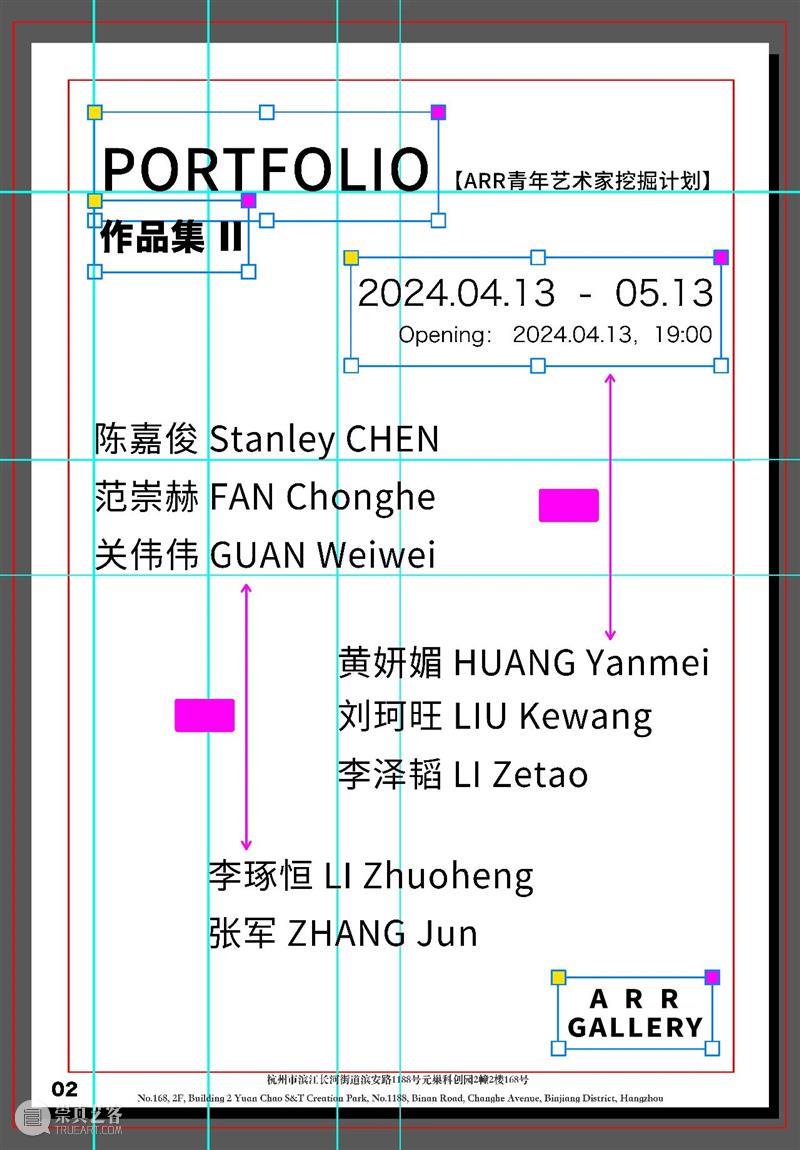
作品集02 Portfolio II
陈嘉俊 Stanley CHEN
范崇赫 FAN Chonghe
关伟伟 GUAN Weiwei
黄妍媚 HUANG Yanmei
刘珂旺 LIU Kewang
李泽韬 LI Zetao
李琢恒 LI Zhuoheng
张军 ZHANG Jun
展览时间:2024年4月13日至2024年5月13日
Duration: 13th April – 13th May, 2024
开幕时间:2024年4月13日,星期六,19:00
Openning: 19:00, Saturday, 13th April, 2024
展览统筹:丁丁
Exhibition Coordinator: DING Ding
地址:浙江省杭州市滨江区长河街道滨安路1188号元巢科创园2幢2楼168号
Address: No.168, 2F, No.2, Yuan Chao S&T Creation Park, No.1188, Binan Road, Changhe Avenue, Binjiang District, Hangzhou
关于采访
陈嘉俊/Stanley Chen
1. 是什么激励了你作为一名职业艺术家?
我曾经在国内小学的美术考试中拿过不及格,也在初中的美术课上被老师取笑过我的声音后再也没有上过美术课,在国际学校被毕业于川美的美术老师针对,在全班面前质疑国际课程的评分机构给我的打分过高。后来转学去了澳洲,我很快意识到自己跟艺术其实很合得来,毕业作品也入选了州级的奖项得到了在新南威尔士州美术馆展览的机会。现在还在画画有三个人很重要,一个是我的妈妈,一个是我在澳洲读高中的美术老师Peter Bamford,一个是我在纽约读大学时鼓励我从插画系转到纯艺系的老师Nancy Chunn。他们让我觉得自己与众不同,这种信念感可以把坏的阶段骗过去。
2. 你觉得艺术风格或者辨识度重要么?你怎么描述你的艺术风格?
辨识度肯定是重要的,风格倒是不清楚。我认为好的艺术作品实际上很难用几个字的风格来形容。风格都是由好多不同的视觉元素按比例调配出来的。视觉上我参考的元素会包括工笔画,郝量/袁旃的作品,西方艺术中像是Alex Katz的作品我也特别喜欢;日本的漫画,再结合一些自己慢慢试验出来的作画方式,但更多的视觉表达我认为来源于潜意识。风格是会随着需要表达的内容去更改的,很难总结。交给艺评家吧,我嘴笨才画画的。
3. 你能分享一件作品背后的故事吗?
这一批带泪的的自画像作品都是在我回国后追求所谓“爱情”狠狠撞墙后的美丽结晶。这里的同性约会有种像在考试的感觉,和我以往在国外的体验是很不一样的,很多人无法表达自己的真实想法,我也时常无视了很多“言下之意”。去年遇过一个喜欢的人,但最后他却把性关系的不和谐归咎到我“不性感”上。我不懂为什么到我最后主动结束这段关系的时候才得知这一件事,明明前面对方有很多拒绝的空间,好像什么都是我逼出来的一样。我们作为一个群体既是性凝视的主体也是客体。所有给予的痛苦总是会在某个时刻像回力镖一样飞旋后敲到自己的脑袋,我无法完全共情这种明显带有恶意的回圈。明明有不去接手,和不去投掷的选择。“不主动,不拒绝,不负责”,好美的排比。我只能做到把自己抽离出来画画,默默地流着像精子一般的眼泪。
4. 你在目前的创作过程中遇到的最大的困难或是焦虑源自哪里?
销售上的经济压力吧。我不认为卖不出去的作品就不是好作品,但作品卖不出去实际上就等于需要放弃全职做艺术,以失去做作品时间的方式作为卖不好的惩罚,也像是给信任自己的画廊的惩罚,画廊很难做艺术家也很难做。我是一个向外索取能量的人,外界和环境对我的影响实际上非常大,别人的评价,销售状况,有没有画廊来跟我约展览实际上都会影响到我的创作产出。而一旦销售成绩不好,我会开始怀疑自己的作品,怀疑自己的创作方向,作品也曾试过因为无人问津而真的质量变差,我会很害怕这件事。
5. 你怎么理解《作品集》这个展览题目的?以及你是如何选择适合这个展览的作品的?
作品集给我的感觉听上去好像是年轻艺术家脱离了艺术学院完美泡泡后,开始接触艺术行业的一份成绩单。合不合格我也说了不算,不过这次的作品是决定全职做艺术后第一批自己真正满意的作品。
6. 合作画廊的地域(这里指城市所在地)对你来说重要吗? 杭州的艺术生态给你什么样的印象?
应当是重要的。比起广东,杭州的艺术氛围要丰富不少,创意产业园区真的会有画廊和一些家居美学的店铺,广东的创意园区基本上都是食肆。除了开幕见到了几位艺术家我还去拜访了其他五位在杭州有工作室的艺术家,之间的交流其实让我产生了不少想法。杭州的国美-本地画廊/艺术机构很好地形成了一个交流的空间,地点也相对集中。
7. 作品的销售情况和市场反馈对你的后续创作有影响吗? 影响在哪里?
会的,创作的母题实际上不会变,但表现的形式可能会进行更改。像我现在就在考虑不做那么多自画像,有时候一些条件的限制说不定会促成一种新的视角。但更有可能的是我需要一份能够养活自己的工作,创作的周期会变长,时间也会变少。
8. 你未来 3 年的计划是什么?
最近有了一个个展的想法,作品会比较幽默和轻松一点。讨论的是中西文化夹缝语境中的都市约会生活,应该还会有一些网感。(暂定标题是:「约瑟夫说我很幽默」Joseph Says I’m Funny)决定好了一些作品的标题,但在画面上还需要做一些视觉调研。有一些旧作品也还挺适合放在这个主题里的。同时我在做明年回澳大利亚生活的打算。顺利的话会在墨尔本读两年研究生,一是好好调整一下自己的创作,二是调整一下我想要的生活。(我不想在国内约会跟开车了天呐!)我这两年回国的目的是想尝试全职做艺术和认识多一些国内的画廊,目前混了点儿脸熟,也认识到了自己的作品或许还未达到能够自给自足的程度,所以想去那边不那么焦虑地创作一段时间。澳大利亚有很足够的最低工资和社会福利,兼职就可以养活自己。长期来说是对我创作有利的,不用逼自己在没有想法的时候也要画画。
9.《作品集》系列展览是 ARR 一个长期的青年艺术家挖掘计划,你有什么感受或建议想要分享给后面参与的艺术家们吗?
挺好的,值得信任。
10. 请给 ARR 提一个意见,让我们共同成长。
我觉得ARR很有潜力,作品的筛选也很认真。拍照存档也很专业。希望ARR能建立一个画廊网站,而且我会建议ARR的instagram用户名可以改一下,别的弄得挺好的。
En:
1. What motivates you as a professional artist?
I once failed an art exam in primary school in China and was ridiculed by my teacher in middle school for my voice. After that, I never took an art class again. At an international school, a fine arts teacher graduated from Sichuan Fine Arts Institute challenged me, questioning the high grades given to me by the international curriculum's grading system in front of the whole class. After transferring to Australia, I quickly realized that I actually resonated well with art. My graduation work was selected for a state-level award, and I got the opportunity to exhibit at the New South Wales Art Gallery. Now, there are three people who are very important to me in painting: my mother, Peter Bamford, my art teacher in high school in Australia, and Nancy Chunn, my teacher in New York who encouraged me to switch from illustration to fine arts. They made me feel unique, and this belief helped me get through the tough times.
2. Do you think artistic style or recognizability is important? How would you describe your artistic style?
Recognizability is definitely important, but style is unclear. I believe that good artworks are actually difficult to describe in a few words of style. Styles are composed of many different visual elements in proportion. The visual elements I refer to include meticulous paintings, works by Hao Liang/Yuan Zhan, and Western art such as Alex Katz's works that I particularly like; Japanese manga, combined with some drawing techniques I experimented with myself. But I think more visual expression comes from the subconscious. Styles will change with the content to be expressed, making them difficult to summarize. I'll leave that to art critics. I'm not good with words; I just draw.
3. Could you share a story behind one of your works?
These tearful self-portrait works were all created after I returned to pursue so-called "love" and crashed into walls. Same-sex dating here feels like taking an exam, which is very different from my experience abroad. Many people cannot express their true thoughts, and I often ignore many "implications". Last year, I met someone I liked, but he attributed the disharmony of our sexual relationship to my "lack of sex appeal". I don't understand why I only learned about this when I took the initiative to end the relationship in the end, when there were many rejections from him before, as if everything was forced out by me. We, as a group, are both subjects and objects of sexual scrutiny. All the pain given will always come back like a boomerang at some point and hit me in the head. I cannot fully empathize with this obvious malicious loop. Clearly, there are choices not to take over and not to throw. "Not taking the initiative, not refusing, not taking responsibility," what a beautiful parallelism. All I can do is detaching myself and paint quietly, shedding tears like sperm.
4. What has been the biggest challenge or source of anxiety in your current creative process?
Economic pressure from sales. I don't believe that works that don't sell are not good works, but when works don't sell.It actually means I have to give up on full-time art, having less time to create as a punishment for the poor sales, which is also a punishment for the galleries’ trust. It’s hard to run a gallery, and it’s difficult to be a full-time artist. I am someone who seeks energy from the outside, and the influence of the outside world and the environment on me is actually very significant. Others' evaluations, sales conditions, and whether there are galleries inviting me to exhibitions will all affect my creative output. Once the sales performance is poor, I will start to doubt my works and the direction of my creation. Works have also deteriorated in quality because of lack of attention, and I am very afraid of this.
5. How do you understand the theme of the exhibition "Portfolio"? And how did you select works suitable for this exhibition?
"Portfolio" gives me the impression that it's like a report card for young artists after they have left the perfect bubble of art school and started to engage with the art industry. Whether it's qualified or not, I don't have the final say, but the works this time are the first batch of works I am truly satisfied with after deciding to do art full-time.
6. Is the location of the collaborating gallery important to you? What impression does Hangzhou's art atmosphere give you?
It should be important. Compared to Guangdong, Hangzhou's art atmosphere is much richer. Creative industrial parks actually have galleries and some home aesthetic shops, while creative parks in Guangdong are basically restaurants. In addition to meeting several artists at the opening, I also visited five other artists who have studios in Hangzhou. The exchange between us actually gave me a lot of ideas. Hangzhou's Guomei-Local Gallery/Art Organization has formed a good space for communication, and the location is relatively concentrated.
7. Do sales and market feedback on your works influence your subsequent creations? If so, how?
Yes, they do. The theme of creation will not change, but the form of expression may change. For example, I am now considering not doing so many self-portraits. Sometimes, the limitations of certain conditions may promote a new perspective. But more likely, I need a job that can support myself, the creation cycle will become longer, and time will become less.
8. What are your plans for the next 3 years?
I recently had an idea for a solo exhibition. The works will be more humorous and relaxed. The discussion is about urban dating life in the context of the squeeze between Chinese and Western cultures. There should also be some internet humor. (Tentative title: "Joseph Says I'm Funny"). I've decided on some titles for the works, but I still need to do some visual research on the images. Some old works are also quite suitable for this theme. At the same time, I am planning to return to Australia next year. If everything goes well, I will study for two years for a master's degree in Melbourne, one is to adjust my creation well, and the other is to adjust the life I want. (I don't want to date and drive in China anymore!) The purpose of my return to China in these two years is to try full-time art and get to know more galleries in China. At present, I have made some acquaintances and realized that my works may not yet be able to support myself independently, so I want to go there and create without so much anxiety for a while. Australia has sufficient minimum wage and social welfare, and part-time work can support me. In the long run, it is beneficial to my creation, without forcing myself to paint when I have no ideas.
9. The "Portfolio" series exhibition is a long-term plan by ARR to discover young artists. Do you have any feelings or suggestions you would like to share with the artists participating in the future?
It's good, trustworthy.
10. Can you provide ARR with a suggestion for mutual growth?
I think ARR has great potential, and the selection of works is also very serious. The photography archiving is also very professional. I hope ARR can establish a gallery website, and I would suggest changing the username on ARR's Instagram, everything else is pretty good.

带泪的自画像/Self Portrait with Tears
2023
石墨,丙烯,水彩,帆布/ Craphite, Acrylic and Watercolor on Canvas
20×25cm
范崇赫/FAN Chonghe
1. 是什么激励了你作为一名职业艺术家?
具体说不上来是什么东?。这些年来,从学画到考美院,从出国留学到毕业后继续创作,尽管中间?了不少弯路,经历过各种?我怀疑和挫折的打击,但?张?张地画下来之后,发现???法舍弃掉这件事,也不想只以?种爱好来维持它。说实话别的?作我都做不了,坐不了班,更不想进体制,感觉身体?总有股劲?,让我把画笔攥得更紧,放不下来。总之,这是?件值得坚持的事情,也必须坚持。
2. 你觉得艺术风格或者辨识度重要么?你怎么描述你的艺术风格?
?少对艺术家来说,没那么重要。如果???思只钻研视觉上的所谓辨识度或者?格,可能从?开始路就?歪了。与其追求标新?异,不如真诚地?对??,认识??。因为这件事更耗时间,更折磨?,也更可贵。画画终究是画??。形成??的作品?貌和语?,是在这个过程中?然?然的事,我觉得我的艺术?格,更准确地说是态度,就是?先对??诚实。
3. 你能分享一件作品背后的故事吗?
《幸福的形状》是?幅今年的新作。创作灵感源?我在路边看到的装饰字招牌。幸福,这个词似乎很难??种普世的语法具像化地去解释。它难以名状,却?往往通过物质化,在?们眼中明晰地存在,就像画?中那样。
4. 你在目前的创作过程中遇到的最大的困难或是焦虑源自哪里?
每张作品的背后都对应着不同的问题和磨炼。有的是关于技术层?的,有的是形式和内容之间的平衡与协调,有的是?我意识和绘画本体的反复纠缠与搏?。没有?张画是容易的,但我?常享受并且珍惜这个过程。
5. 你怎么理解《作品集》这个展览题目的?以及你是如何选择适合这个展览的作品的?
“作品集”让我想到出国留学的那段时光,我也帮周围的朋友们做过?些作品集的排版。按照我的理解,它应该是对艺术家?定时期内最具代表性的作品的集中呈现。就像本次展览我的五幅作品,创作时间从2022年到2024年,我认为能够向?家展现这两年来??的?个阶段性?貌。
6. 合作画廊的地域(这里指城市所在地)对你来说重要吗? 杭州的艺术生态给你什么样的印象?
我没太考量过这个因素。我看重的是画廊是否本着负责任的态度与艺术家合作,以及对?个展览或项?的呈现是否专业(ARR在这两个??都做得?常棒)我这回是第?次来杭州,很幸运能够认识很多本地艺术家,并且参观拜访了他们的?作室。杭州的艺术?态给我的第?感觉就是?家很团结,状态都很放松,但同时对待??的创作仍是?常认真严肃的。
7. 作品的销售情况和市场反馈对你的后续创作有影响吗? 影响在哪里?
这个问题对于我多少有点超纲了,我更在乎周围的艺术家朋友对我的反馈与建议,从他们身上我学到很多。
8. 你未来 3 年的计划是什么?
继续画,不断深?和完善??的作品。条件允许的话,换?个??点?的?作室。
9.《作品集》系列展览是 ARR 一个长期的青年艺术家挖掘计划,你有什么感受或建议想要分享给后面参与的艺术家们吗?
我想引??位已故的?为艺术家Pope.L在?前采访中说的?段话 ”To be patient, and to be ignorant of what you think you knowand if you don’t get the answer that you are expecting, maybe that’s a good thing. Knowing what you‘re doing is overrated.”
10. 请给 ARR 提一个意见,让我们共同成长。
?家都很棒。愿我们都能朝着??坚信的未来义?反顾地前进。
En:
1. What motivates you as a professional artist?
I can't pinpoint exactly what it is. Over the years, from learning to paint to studying at the academy, from studying abroad to continuing to create after graduation, despite taking many detours in between, experiencing various self-doubts and setbacks, I found that I couldn't give up on this thing and didn't want to sustain it just as a hobby. To be honest, I can't do other jobs. I can't sit in an office, and I definitely don't want to be part of the system. It feels like there's always a force inside me that makes me grip the brush tighter, unable to let go. In short, this is something worth sticking to, and it must be persisted.
2. Do you think artistic style or recognizability is important? How would you describe your artistic style?
At least for artists, it's not that important. If a person only focuses on the so-called recognizability or style visually, they might have gone the wrong way from the beginning. Instead of pursuing novelty, it's better to face oneself sincerely and get to know oneself, because this takes more time and is more torturous, but it's more valuable. Painting is ultimately about painting oneself, forming one's own appearance and language in the process naturally. I think my artistic style, more accurately speaking, is an attitude, which is first and foremost honesty with oneself.
3. Could you share a story behind one of your works?
"The Shape of Happiness" is a new work this year. The inspiration comes from a decorative sign I saw on the roadside, "Happiness." This word seems difficult to explain in concrete terms universally; it's indescribable but often manifests clearly through materialization, existing vividly in people's eyes, just like in the painting.
4. What has been the biggest challenge or source of anxiety in your current creative process?
Behind each work corresponds to different issues and trials. Some are about technical aspects, some about the balance and coordination between form and content, and some about the repeated entanglement and struggle between self-awareness and the essence of painting. No painting is easy, but I enjoy and cherish this process immensely.
5. How do you understand the theme of the exhibition "Portfolio"? And how did you select works suitable for this exhibition?
"Portfolio" reminds me of the time studying abroad. I have also helped some friends around me with the layout of their portfolios. From my understanding, it should be a concentrated presentation of the most representative works of an artist during a certain period, like the five works I have in this exhibition, created from 2022 to 2024. I think it can show everyone a phase of myself over the past two years.
6. Is the location of the collaborating gallery important to you? What impression does Hangzhou's art atmosphere give you?
I haven't really considered this factor. What I value is whether the gallery cooperates with artists responsibly and whether the presentation of an exhibition or project is professional. ARR has done a great job in both aspects. This is my first time in Hangzhou. I am very lucky to meet many local artists and visit their studios. The first impression of Hangzhou's art ecology is that everyone is very united and relaxed, but at the same time, they treat their own creations very seriously.
7. Do sales and market feedback on your works influence your subsequent creations? If so, how?
This question is somewhat beyond my scope. I care more about the feedback and suggestions from artist friends around me. I have learned a lot from them.
8. What are your plans for the next 3 years?
Keep painting, continuously delve into and perfect your own works. If conditions allow, get a bigger studio.
9. The "Portfolio" series exhibition is a long-term plan by ARR to discover young artists. Do you have any feelings or suggestions you would like to share with the artists participating in the future?
I want to quote a passage from a late performance artist, Pope.L, in an interview: "To be patient, and to be ignorant of what you think you know, and if you don’t get the answer that you are expecting, maybe that’s a good thing. Knowing what you’re doing is overrated."
10. Can you provide ARR with a suggestion for mutual growth?
Everyone is great. May we all move forward towards our believed future without hesitation.
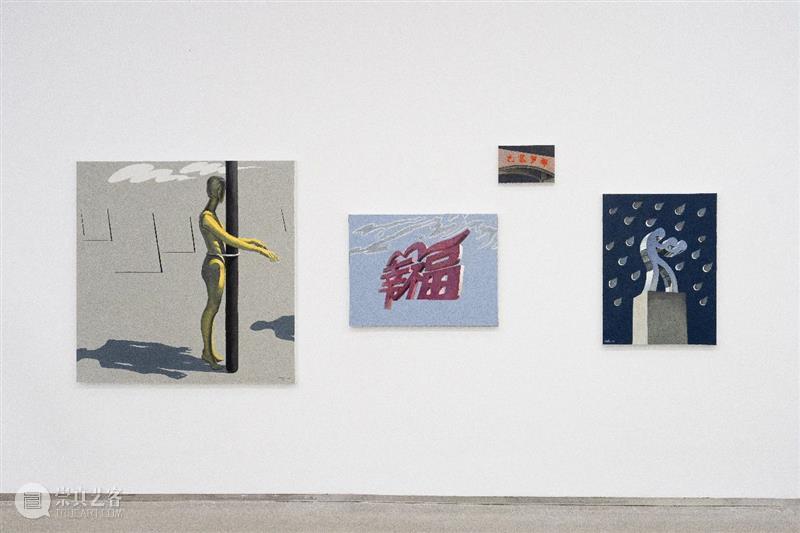
关伟伟/GUAN Weiwei
1. 是什么激励了你作为一名职业艺术家?
做自己喜欢的事情。
2. 你觉得艺术风格或者辨识度重要么?你怎么描述你的艺术风格?
重要,但要真诚。简单的,单色的。
3. 你能分享一件作品背后的故事吗?
《雨夜》这件作品是23年新作的一个节点和转折,在创作它的的过程出了些问题,为了继续下去把已有的图像用黑色进行了覆盖,接着用最直接的铅笔作为工具对图像内容再塑造,最后完成了作品,有种失而复得的感觉。
4. 你在目前的创作过程中遇到的最大的困难或是焦虑源自哪里?
经常提醒自己不要陷入惯性思考,但又无法避免。
5. 你怎么理解《作品集》这个展览题目的?以及你是如何选择适合这个展览的作品的?
认真负责且专业的做一件具有开放性和不确定性的事情。没有刻意选择适合展览的作品,就是选了近期的作品。
6. 合作画廊的地域(这里指城市所在地)对你来说重要吗? 杭州的艺术生态给你什么样的印象?
不重要。最近几年出现了多家艺术机构和画廊。
7. 作品的销售情况和市场反馈对你的后续创作有影响吗? 影响在哪里?
对创作没有直接影响,但是影响经济收入也会导致生活质量的不稳定。
8. 你未来 3 年的计划是什么?
继续探索现在这个系列的作品,会尝试些三维立体的创作。
9.《作品集》系列展览是 ARR 一个长期的青年艺术家挖掘计划,你有什么感受或建议想要分享给后面参与的艺术家们吗?
经常思考,真诚创作。
10. 请给 ARR 提一个意见,让我们共同成长。
一直存在,一直优秀。
En:
1. What motivates you as a professional artist?
Doing what I love.
2. Do you think artistic style or recognizability is important? How would you describe your artistic style?
Important, but it needs to be sincere. Simple and monochromatic.
3. Could you share a story behind one of your works?
The piece "Rainy Night" marks a turning point in my recent work. During its creation, I encountered some issues, so I covered the existing imagery in black to continue. Then, I reshaped the content with a pencil, resulting in a sense of regained loss.
4. What has been the biggest challenge or source of anxiety in your current creative process?
Constantly reminding myself not to fall into habitual thinking, yet unable to avoid it.
5. How do you understand the theme of the exhibition "Portfolio"? And how did you select works suitable for this exhibition?
Taking on an open and uncertain task with seriousness and professionalism. I didn't intentionally choose works suitable for the exhibition, I simply selected recent pieces.
6. Is the location of the collaborating gallery important to you? What impression does Hangzhou's art atmosphere give you?
Not important. In recent years, numerous art institutions and galleries have emerged in Hangzhou.
7. Do sales and market feedback on your works influence your subsequent creations? If so, how?
They don't directly influence my creations, but economic fluctuations can lead to unstable living conditions.
8. What are your plans for the next 3 years?
To continue exploring the current series of works and to experiment with three-dimensional creations.
9. The "Portfolio" series exhibition is a long-term plan by ARR to discover young artists. Do you have any feelings or suggestions you would like to share with the artists participating in the future?
Think deeply and create sincerely.
10. Can you provide ARR with a suggestion for mutual growth?
Stay present and stay excellent.

雨夜/A Rainy Night
2022
木板上纸,国画颜料,丙烯,铅笔
Chinese Ink, Acrylic, Pencil, Paper on Board
80×120cm
黄妍媚/HUANG Yanmei
1. 是什么激励了你作为一名职业艺术家?
没有很具体的原因,好像一直以来做的选择跟决定都是不是我想要做什么而更多的是我不想做什么而做的选择。所以目前来说,画画是最想做的事,职业这个话题我是有点谨慎,害怕,怕会变得没那么纯粹,带有目的性,变得没那么轻松的状态。
2. 你觉得艺术风格或者辨识度重要么?你怎么描述你的艺术风格?
蛮重要的吧。图像可能有点趣味性,亲昵性,但手法上又有点写实,有种日常的事物但又呈现有某种熟悉又冰冷的感觉。我也是偶然间发现自己莫名地很爱画对称性,旋转的构图。
3. 你能分享一件作品背后的故事吗?
有一张画《欢快招手》是我去成都一个广场拍的毛主席的雕塑,回来之后对招手这个动作觉得有点好玩,然后便把挥手的动作过程画下来,后续把平时说的“踢皮球”的具象化为一圈球环绕在手周围,整个过程有点莫名其妙,但就是我脑子当下看到图像时本能地串联起来的。
4. 你在目前的创作过程中遇到的最大的困难或是焦虑源自哪里?
目前来说可能是自己出稿不稳定,有时候画近10个稿子都感觉不对,有时候画一个就觉得是它了,直接上画布。还有一个问题可能是我的工作方法,稿子时常大概一个速写稿子就开始画,素描关系,色彩关系都没想清楚,很多关系和图像都是画着画着感觉要增加或者删除,所以整个过程有点反复,所以有时候会陷入自我怀疑。但很矛盾,因为是试过把稿子画的很完整去上画布的,觉得很没意思,所以可能这个工作方法我还需要再试试看怎么调整。
5. 你怎么理解《作品集》这个展览题目的?以及你是如何选择适合这个展览的作品的?
对我来说作品集这个题目像是一个小白刚刚完成一些画作,然后抱着热忱的心态去参加展览,就有那种稚嫩,未见世事的感觉。我挑的几张可能都是我某个阶段的一些转折点的画,画面中有某些元素我觉得比较能代表我的画作。
6. 合作画廊的地域(这里指城市所在地)对你来说重要吗? 杭州的艺术生态给你什么样的印象?
挺重要的吧,毕竟不同城市的艺术生态不一样,说不在意销售情况如何这话对我来说有点虚伪了,但还是要警惕。其实杭州我没去过,大概的了解是感觉目前国内的大城市感觉艺术生态大多都比广州好,不知道是广州人太务实了吗,感觉没啥年轻的气息,画廊也很少很少,感觉杭州好像最近的展览反而比较活跃,年轻化。
7. 作品的销售情况和市场反馈对你的后续创作有影响吗? 影响在哪里?
有吧。首先可能算是让自己稍微坚定一点,稍微被肯定了的感觉,毕竟也做不到太久的纯用爱发电,发现自己的画被喜欢还是会本能的开心一下。但可能我本身性格有点患得患失,也会很快的陷入那种因为别人的喜欢或者不喜欢对自己心境的影响的反感,会害怕失去自己的判断。
8. 你未来 3 年的计划是什么?
明年研究生毕业后,暂时是不想再接着读下去的了,有点乏了,想着看看找个差不多时间比较自由的工作,做点兼职啥的也行,能大致养活自己,闲暇时间比较多,就周末上班那种,然后能接着画画啥的。想着稍微集中一点精力画画,我也好奇自己能走到哪一步。
9.《作品集》系列展览是 ARR 一个长期的青年艺术家挖掘计划,你有什么感受或建议想要分享给后面参与的艺术家们吗?
好好画画,会发现还是有不少机会的,前提可能就是自己先不要放弃。然后就是我觉得跟画廊之间达成那种信任,平等的状态,良好的沟通,互相尊重。
10. 请给 ARR 提一个意见,让我们共同成长。
这次开幕我也没去到现场,其余目前的感觉都挺好的,沟通对接上的感觉也没问题,就希望ARR能坚持下去,然后保持现有的真诚的态度吧!也希望画廊跟艺术家的关系能维持一种良性的状态,商业的同时不忘继续探讨艺术,也希望说画廊和艺术家之间能达成一个长期的合作关系,平等,互相信任!
En:
1. What motivates you as a professional artist?
There isn't a specific reason. It feels like most of the choices and decisions I've made were not so much about what I wanted to do but more about what I didn't want to do. So, for now, painting is what I want to do most. I'm a bit cautious about the topic of being a professional, afraid that it might become less pure, more purposeful, and less relaxed.
2. Do you think artistic style or recognizability is important? How would you describe your artistic style?
It's quite important. The imagery might have some playfulness, intimacy, but the technique is somewhat realistic, presenting a familiar yet cold feeling. I've also noticed that I love drawing symmetry and rotating compositions.
3. Could you share a story behind one of your works?
There's a painting titled "Cheerful Wave," which I took from a sculpture of Chairman Mao in a square in Chengdu. After returning, I found the waving motion quite amusing, so I depicted the process of waving. Later, I visualized the expression "kicking a ball" into a circle of balls surrounding the hand. The whole process was a bit whimsical, but it was instinctively linked in my mind when I saw the imagery.
4. What has been the biggest challenge or source of anxiety in your current creative process?
Currently, it might be the instability of my drafts. Sometimes I feel like none of the nearly 10 drafts are right, and other times, one feels just right to put directly onto the canvas. Another issue might be my working method. I often start with a rough sketch without clear ideas about the sketch or color relations. Many relations and images are added or deleted as I paint, so the whole process feels repetitive, leading to self-doubt at times. But it's contradictory because I've tried completing drafts thoroughly before transferring them onto canvas and found it quite uninteresting. So maybe I need to try adjusting this working method again.
5. How do you understand the theme of the exhibition "Portfolio"? And how did you select works suitable for this exhibition?
For me, the theme of "Portfolio" feels like a novice who has just completed some paintings and eagerly participates in an exhibition, with that sense of innocence and inexperience. The pieces I selected are probably some turning point works from a certain stage, with certain elements in the images that I feel represent my artwork well.
6. Is the location of the collaborating gallery important to you? What impression does Hangzhou's art atmosphere give you?
It's quite important. After all, the art atmosphere in different cities vary. Saying that I don't care about sales figures would be a bit hypocritical for me, but I still need to be cautious. I haven't been to Hangzhou myself, but from what I know, the art atmosphere in most major cities in China seems to be better than Guangzhou. I'm not sure if it's because people in Guangzhou are too pragmatic; it feels like there's not much youthful vibe, and there are very few galleries. Hangzhou seems to have a more active and youthful exhibition atmosphere recently.
7. Do sales and market feedback on your works influence your subsequent creations? If so, how?
Yes. Firstly, it may help to firm up my confidence a bit. After all, I can't purely rely on passion for too long. When I find out that someone likes my painting, I instinctively feel happy. But maybe because of my personality, I quickly fall into a state of dissatisfaction due to the influence of others' likes or dislikes on my mood. I'm afraid of losing my judgment.
8. What are your plans for the next 3 years?
After graduating from masters next year, I don't really want to continue studying further. I'm a bit tired. I'm thinking of finding a job that allows for more freedom, maybe some part-time work, enough to support myself, with more free time, like working on weekends, and then continuing to paint. I want to concentrate a bit more on painting, and I'm curious about how far I can go.
9. The "Portfolio" series exhibition is a long-term plan by ARR to discover young artists. Do you have any feelings or suggestions you would like to share with the artists participating in the future?
Keep painting well, and you'll find there are still many opportunities, as long as you don't give up first. Also, I think it's important to establish a relationship of trust, equality, and good communication between artists and galleries, and to respect each other.
10. Can you provide ARR with a suggestion for mutual growth?
I didn't attend the opening event this time, but everything else feels pretty good so far. The communication and coordination seem fine, so I hope ARR can keep it up and maintain its current sincere attitude! Also, I hope the relationship between the gallery and the artists can maintain a healthy state, where commercialism coexists with continuous exploration of art. I also hope that a long-term cooperative relationship based on equality and mutual trust can be established between the gallery and the artists!

一把鼻涕一把泪/A Snot and A Tear
2024
布面油画/ Oil on Canvas
80×60cm
刘珂旺/LIU Kewang
1. 是什么激励了你作为一名职业艺术家?
可能是因为我是学画画的。
2. 你觉得艺术风格或者辨识度重要么?你怎么描述你的艺术风格?
重要,没有辨识度咋能认出来呢? 旋风土豆风。
3. 你能分享一件作品背后的故事吗?
我作品中的“蝴蝶”这一符号来源我小时候的一些经历,蝴蝶是我很害怕的虫子,我以前以为蝴蝶只有两片翅膀,我就觉得很漂亮,还挺喜欢的,但是我妈出去旅游的时候给我带回来的蝴蝶标本把我吓到了,我还记得那个盒子外面是用红色的类似于绸缎的布给包着的,那是我第一次近距离的看见蝴蝶中间的虫子,我就觉得好吓人,从那之后我就开始害怕蝴蝶了。
4. 你在目前的创作过程中遇到的最大的困难或是焦虑源自哪里?
对自我的不认同感,让我很焦虑。
5. 你怎么理解《作品集》这个展览题目的?以及你是如何选择适合这个展览的作品的?
为青年艺术家们提供展示自己的机会。我选择的是代表我不同时期所做的对同一个主题的表达。
6. 合作画廊的地域(这里指城市所在地)对你来说重要吗? 杭州的艺术生态给你什么样的印象?
对我个人来说,地域性没那么重要,我所做的东西更多的是自我表达,给我的印象挺好的。
7. 作品的销售情况和市场反馈对你的后续创作有影响吗? 影响在哪里?
肯定会有影响,影响我的自我认同感,我是一个很不自洽的人,我需要他人的认同。很别扭,因为我做的东西又是自我表达。
8. 你未来 3 年的计划是什么?
继续画画。
9.《作品集》系列展览是 ARR 一个长期的青年艺术家挖掘计划,你有什么感受或建议想要分享给后面参与的艺术家们吗?
保持积极向上阳光的心态,保持创作,保持活着。
10. 请给 ARR 提一个意见,让我们共同成长。
挺好的挺好的。
En:
1. What motivates you as a professional artist?
Possibly because I studied art.
2. Do you think artistic style or recognizability is important? How would you describe your artistic style?
Important. Without recognizability, how can one be recognized? It's like a whirlwind potato style.
3. Could you share a story behind one of your works?
The symbol of "butterfly" in my works comes from some of my childhood experiences. Butterflies used to be a scary insect for me. I thought they only had two wings, which I found beautiful and quite liked. But when my mom brought back a butterfly specimen from her trip and I saw the insect in the middle up close for the first time, it scared me. I remember the box was wrapped in red cloth-like silk. Since then, I've been afraid of butterflies.
4. What has been the biggest challenge or source of anxiety in your current creative process?
Lack of self-identification makes me very anxious.
5. How do you understand the theme of the exhibition "Portfolio"? And how did you select works suitable for this exhibition?
It provides an opportunity for young artists to showcase themselves. I chose works that represent my expression of the same theme at different times.
6. Is the location of the collaborating gallery important to you? What impression does Hangzhou's art atmosphere give you?
Location is not that important to me personally. What I do is more about self-expression. Hangzhou's art atmosphere gives me a good impression.
7. Do sales and market feedback on your works influence your subsequent creations? If so, how?
It definitely has an impact, affecting my self-identification. I'm quite contradictory because I need validation from others, yet what I create is self-expression.
8. What are your plans for the next 3 years?
Continue painting.
9. The "Portfolio" series exhibition is a long-term plan by ARR to discover young artists. Do you have any feelings or suggestions you would like to share with the artists participating in the future?
Maintain a positive and optimistic attitude, keep creating, and keep living.
10. Can you provide ARR with a suggestion for mutual growth?
It's going well, keep it up.
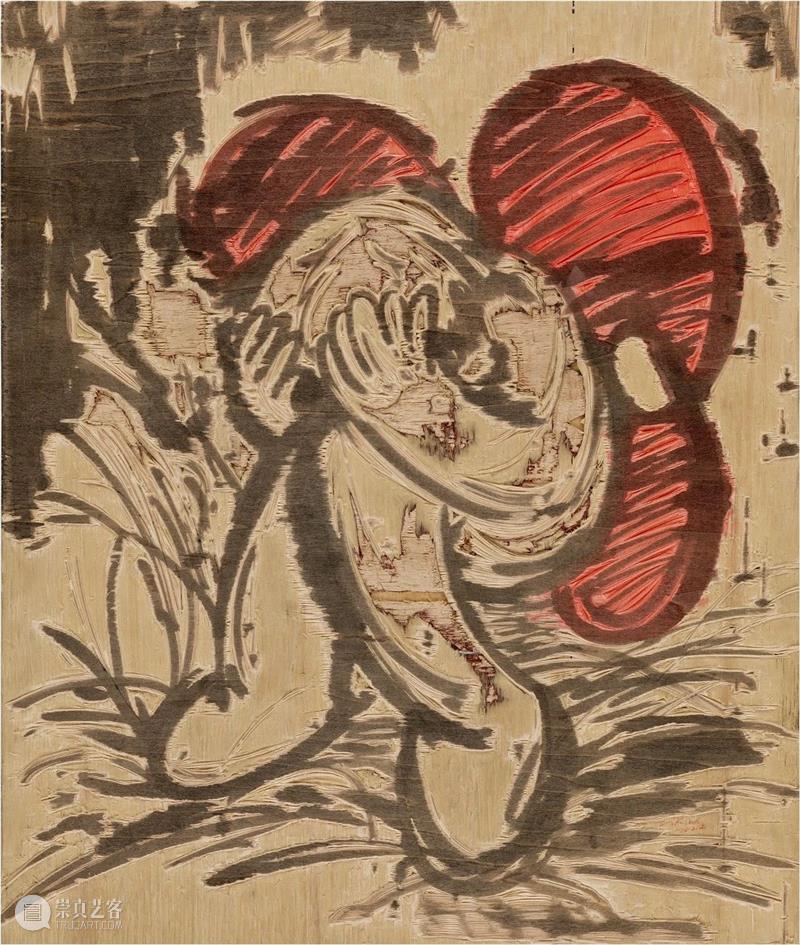
妈妈,我真的画不出来了/Mom, I Really Can't Draw Anymore
2023
木刻原版,水彩设色/ Watercolor on Printmaking Board
50×42cm
李泽韬/LI Zetao
1. 是什么激励了你作为一名职业艺术家?
目前这个环境有些自己关注的事好像只能通过艺术才有表达的可能。
2. 你觉得艺术风格或者辨识度重要么?你怎么描述你的艺术风格?
我觉得辨识度是根植于个人表达的,当一个艺术家的表达足够精准,那么他的辨识度自然会呈现出来。
3. 你能分享一件作品背后的故事吗?
《螺丝》这张。看到朋友布展的时候使用的膨胀螺丝,突然对这个物件有一些感触。螺丝钉对膨胀螺丝的挤压,膨胀螺丝随之破裂,最后卡死在墙上的洞中,这几者之间关系还挺有意思的。
4. 你在目前的创作过程中遇到的最大的困难或是焦虑源自哪里?
前期对于研究问题的梳理,以及转化的精确程度。
5. 你怎么理解《作品集》这个展览题目的?以及你是如何选择适合这个展览的作品的?
能展现出自己研究的问题,同时也能有个系统性的表达。
6. 合作画廊的地域(这里指城市所在地)对你来说重要吗? 杭州的艺术生态给你什么样的印象?
不重要。挺好的,很多艺术家一起能够互相交流。
7. 作品的销售情况和市场反馈对你的后续创作有影响吗? 影响在哪里?
没有影响,能够把自己想表达的东西传递出来给更多的人看就够了。
8. 你未来 3 年的计划是什么?
把当下所研究的问题继续深入,结合画面的转化能有一定程度的推进。
9.《作品集》系列展览是 ARR 一个长期的青年艺术家挖掘计划,你有什么感受或建议想要分享给后面参与的艺术家们吗?
松弛点就好。
10. 请给 ARR 提一个意见,让我们共同成长。
现在就挺好的,一种稳步向前的感觉。
En:
1. What motivates you as a professional artist?
Currently, it seems that some of the things I care about can only be expressed through art.
2. Do you think artistic style or recognizability is important? How would you describe your artistic style?
I think recognizability is rooted in personal expression. When an artist's expression is precise enough, their recognizability naturally emerges.
3. Could you share a story behind one of your works?
"Screw." When I saw the expanding screw used in a friend's exhibition, I suddenly felt something about this object. The compression of the screw against the expanding screw, the subsequent rupture of the expanding screw, and finally getting stuck in the hole in the wall, the relationship between these elements is quite interesting.
4. What has been the biggest challenge or source of anxiety in your current creative process?
The initial clarification of research questions and the precision of transformation.
5. How do you understand the theme of the exhibition "Portfolio"? And how did you select works suitable for this exhibition?
Being able to showcase my research questions while also having a systematic expression.
6. Is the location of the collaborating gallery important to you? What impression does Hangzhou's art atmosphere give you?
Not important. It's quite good; many artists can exchange ideas together.
7. Do sales and market feedback on your works influence your subsequent creations? If so, how?
It doesn't affect me. Being able to convey what I want to express to more people is enough.
8. What are your plans for the next 3 years?
To further delve into the research questions I'm currently studying and to have some progress in the transformation of images.
9. The "Portfolio" series exhibition is a long-term plan by ARR to discover young artists. Do you have any feelings or suggestions you would like to share with the artists participating in the future?
Just relax a bit.
10. Can you provide ARR with a suggestion for mutual growth?
Things are going well now, with a sense of steady progress.
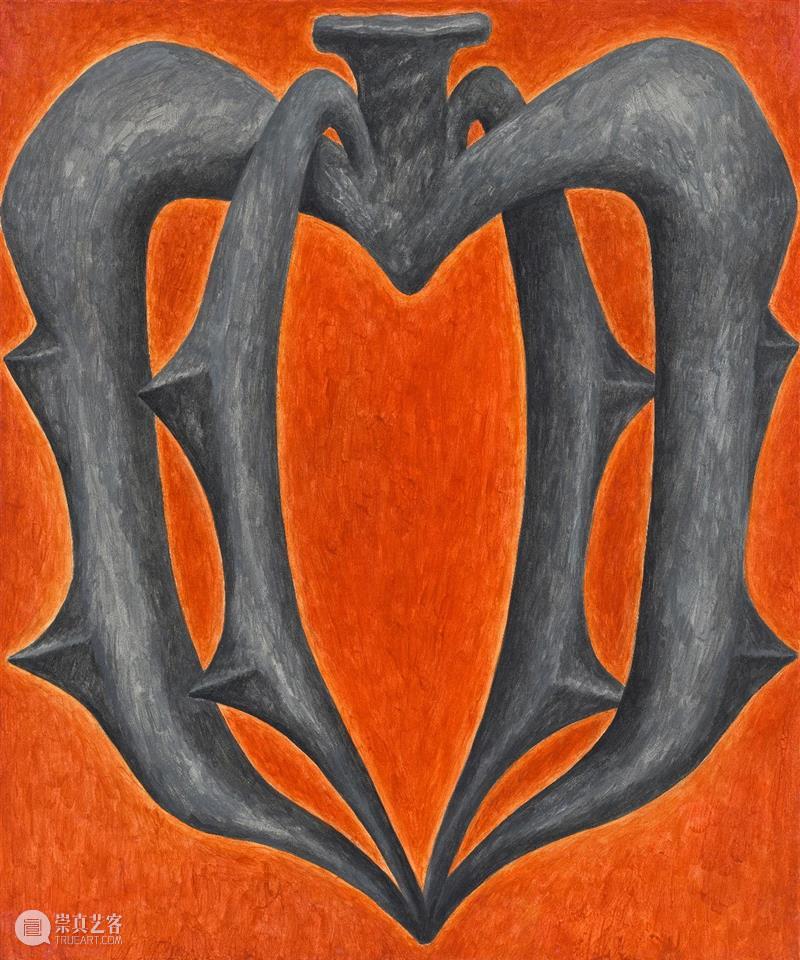
螺丝/Screw
2023
布面丙烯/ Acrylic on Canvas
60×50cm
李琢恒/LI Zhuoheng
1. 是什么激励了你作为一名职业艺术家?
不想上班,但得活着。
2. 你觉得艺术风格或者辨识度重要么?你怎么描述你的艺术风格?
艺术风格这东西就像人一样,本来老老实实做自己每个人都有各自的风格,但如果照着某个网红脸去整容,那必然都是千篇一律。至于我的风格,一种游戏质感的场景吧!至少目前来看是这样,也许未来某一天当我的认知改变了这个所谓的风格也会变成什么样子也说不准~不过我可以聊聊我大概的一个创作背景,便于大家了解我为什么是这样的一种作品面貌:
自19年始,我对这个世界的认知发生了某些改变,一切似乎都失去了真实的质感,这种不真实感是一个危险的信号,因为人很容易在这种不真实中陷入虚无。为了对抗虚无,我便从宗教,哲学和物理学中寻找意义...在我构建的认知系统中,这个世界宛如一场虚拟的游戏,抑或是一出盛大的戏剧,因此,我使用一种带有游戏质感的画面来处理图像,很多作品中也会出现对称性的符号来影射这出戏剧的帷幕。
柏拉图在《理想国》中提到的“洞穴”就是我们肉体生存的可感世界,这是一个建立在数学原理和物理法则之上的世界。人在这个世界上只有感受是真实的,所有的体验不过是一些频率的波动,声波、光波、电信号这些东西都可以用0和1来编码。然而人可以感知到的又仅仅是这些频率中非常狭窄的一部分,说白了,我们与“盲人”无异。因此,在我的创作中,我设计了一系列场景,譬如,将人类的感知系统遮蔽,使人类置于一种无感知状态,相反“非人类”,也许是未来的人造智能体或智慧体,我会赋予它某些人性的东西。
我并不知道未来科技会将人类带向何处,至少目前来,眼下的现实却已经模糊了虚拟与真实的分界线。或许我们皆是身处其中,沉浸式的体验了一场或荒诞、或美好的戏剧。只是这场戏剧显得如此逼真,以至于我们忘记了踏入游戏的那一刻...
3. 你能分享一件作品背后的故事吗?
我的工作方式并不是一件一件的单内容输出,而是搭建一个相对完整的架构之后再向内延生,单独一件作品的话就像电影里的一帧,并无个体意义。
4. 你在目前的创作过程中遇到的最大的困难或是焦虑源自哪里?
焦虑源自知识的积累跟不上遗忘的速度,自从得了新冠之后记忆力变得非常差,以前读过的书,看过的东西,转眼就忘记了。
5. 你怎么理解《作品集》这个展览题目的?以及你是如何选择适合这个展览的作品的?
作品集是艺术家开始产出作品从点到面的的完整系统,首先一个艺术家不能用一件作品来说话,当它没有上下文的时候,一件作品是不成立的。对于画廊也是这样,我们这些艺术家就是一个点,画廊通过找到这些点共通的地方再将它组合成一个面。
这次展览的作品选择的两件作品一个是自然场景,一个是人造物。分别代表了我作品中的的两条线,在篇幅有限的情况下,这两条线的确是我很重要的一个结构设定。
6. 合作画廊的地域(这里指城市所在地)对你来说重要吗? 杭州的艺术生态给你什么样的印象?
并不重要,因为我的作品没有地域性的语境需要。杭州的艺术生态给我一种舒适感,当然不能以偏概全,至少这次是给我这种感觉。
7. 作品的销售情况和市场反馈对你的后续创作有影响吗? 影响在哪里?
当然有影响的,因为是职业艺术家,要靠这个生活的,做艺术总要有正向反馈才能支撑后续的创作。
8. 你未来 3 年的计划是什么?
计划赶不上变化,踏踏实实做好自己的事比什么都强。
9.《作品集》系列展览是 ARR 一个长期的青年艺术家挖掘计划,你有什么感受或建议想要分享给后面参与的艺术家们吗?
我其实是不太敢建议的,接触了这次展览的艺术家大部分比我年龄小,他们都比我优秀。
10. 请给 ARR 提一个意见,让我们共同成长。
这是第一次跟ARR合作,锴哥跟小花姐他们做事专业负责做人友善周到,是我目前为止合作过最好的,还有ARR其他的工作伙伴,也都非常靠谱,有这样的团队画廊怎么可能做不好呢?
En:
1. What motivates you as a professional artist?
Not wanting to work a regular job, but needing to survive.
2. Do you think artistic style or recognizability is important? How would you describe your artistic style?
Artistic style is like a person; everyone naturally has their own style. But if you try to copy a certain popular style, then everything becomes uniform. As for my style, it's a kind of gaming texture scene! At least, that's how it appears for now. Perhaps someday when my perception changes, this so-called style will change too. But I can talk about the background of my creation, to help everyone understand why my works look like this: Since 2019, my perception of the world has changed in some ways. Everything seems to have lost its real texture, and this sense of unreality is a dangerous signal, as people are prone to falling into nothingness. To combat this, I sought meaning from religion, philosophy, and physics... In the cognitive system I constructed, the world is like a virtual game or a grand drama. Therefore, I use images with a gaming texture to deal with images, and many works also incorporate symmetrical symbols to allude to the curtain of this drama. Plato's "cave" mentioned in "The Republic" is the perceivable world of our physical existence, a world built on mathematical principles and physical laws. In this world, only sensations are real, and all experiences are just fluctuations in frequency; sound waves, light waves, electrical signals, all of these things can be encoded in 0s and 1s. However, what humans can perceive is only a very narrow part of these frequencies. In my creations, I design a series of scenes, for example, by blocking human perception systems, placing humans in a state of non-perception. Conversely, for "non-humans," perhaps future artificial intelligences or wise beings, I would give them some human characteristics. I don't know where future technology will lead humanity, but at least for now, the reality is blurred between the virtual and the real. Perhaps we are all immersed in it, experiencing a play that is either absurd or beautiful. It's just that this play seems so real that we forget the moment we entered the game...
3. Could you share a story behind one of your works?
My way of working is not about outputting one piece of content at a time, but building a relatively complete framework and then expanding internally. A single piece of work is like a frame in a movie, without individual meaning.
4. What has been the biggest challenge or source of anxiety in your current creative process?
Anxiety arises from the inability to accumulate knowledge as fast as forgetting. Since I got COVID-19, my memory has became very poor, and I forget things I read or saw before in the blink of an eye.
5. How do you understand the theme of the exhibition "Portfolio"? And how did you select works suitable for this exhibition?
A portfolio is a complete system for artists to start producing works from points to surfaces. Firstly, an artist cannot speak with just one piece of work; when it lacks context, a single piece of work is not valid. The same goes for galleries; we artists are like points, and the gallery finds common ground among these points to create a surface. The two works selected for this exhibition represent two lines in my work. Given the limited space, these two lines are indeed an important structural setting for me.
6. Is the location of the collaborating gallery important to you? What impression does Hangzhou's art atmosphere give you?
Location is not important because my works do not require geographical context. Hangzhou's art atmosphere gives me a sense of comfort, but I cannot generalize; at least, this time, that's the feeling it gives me.
7. Do sales and market feedback on your works influence your subsequent creations? If so, how?
Of course, it does. As a professional artist, I rely on this for a living, and positive feedback on art is needed to support subsequent creations.
8. What are your plans for the next 3 years?
Plans can't keep up with changes. Doing your own thing steadfastly is better than anything else.
9. The "Portfolio" series exhibition is a long-term plan by ARR to discover young artists. Do you have any feelings or suggestions you would like to share with the artists participating in the future?
I'm actually not brave enough to make suggestions. Most of the artists I've met in this exhibition are younger than me, and they are all better than me.
10. Can you provide ARR with a suggestion for mutual growth?
This is the first time I've worked with ARR. Boss Yao and Xiao Hua are professional, responsible, friendly, and thoughtful. They are the best partners I have worked with so far. Also, other colleagues at ARR are very reliable. With such a team, how can the gallery not do well?
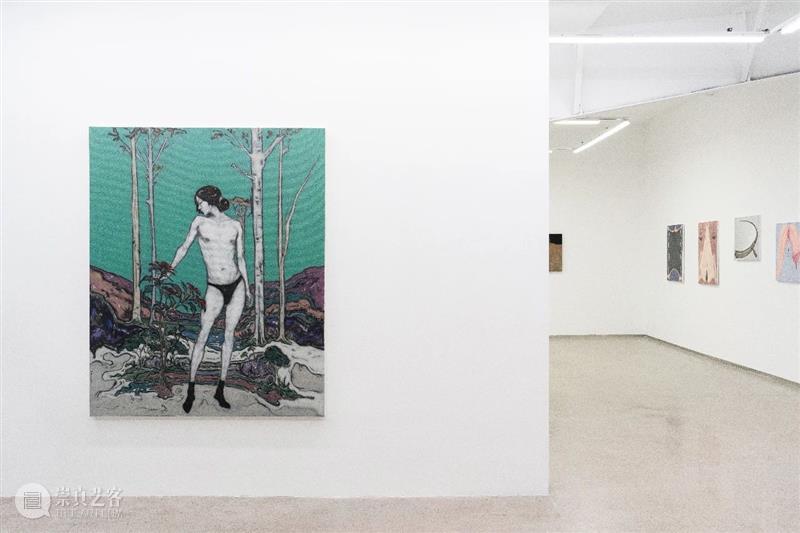
张军/ZHANG Jun
1. 是什么激励了你作为一名职业艺术家?
作为职业艺术家也是一个行业,既然选择了坚持走下去就好,用画面去表达自己真实的想法是个很有意思的事情。
2. 你觉得艺术风格或者辨识度重要么?你怎么描述你的艺术风格?
找到自己的造型语言还是挺重要的,我觉得我的艺术风格不太好确定。
3. 你能分享一件作品背后的故事吗?
疫情期间养了很多被截断的没有任何根系的树桩,尝试让它重新生根发芽,研究它的生长方式以便更好的来衔接创作,这期间种活了一部分也有很多变成了干柴,后来在根部放了一些东西,在这个过程中发现内部的生命力非常活跃并且具有冲击力,对于密度低的材质会直接穿透,而对于密度高的材质则进行了包裹与覆盖。之后对植物的叶子进行了整体去除以便重新生长,发现从一种生机盎然的状态瞬间转化为视觉无法分辨任何生命体征的状态,表面看起来是极度静止的,它不是一种瞬间的定格,而是类似于时间与空间的静止,感觉不到有任何的后续运动,属于生命绽放的永久性凝结,并且这种外部的静止跟内部的澎湃生命力形成了很强烈的对比,成为一个既冲突又融合的闭环。
4. 你在目前的创作过程中遇到的最大的困难或是焦虑源自哪里?
最大的困难就是构思吧,因为我的作品没有任何参照,全是想象出来的。
5. 你怎么理解《作品集》这个展览题目的?以及你是如何选择适合这个展览的作品的?
《作品集》这个展览题目感觉就是在发现新的艺术家和新的艺术形式。
6. 合作画廊的地域(这里指城市所在地)对你来说重要吗? 杭州的艺术生态给你什么样的印象?
地域不重要,下个问题无法回答,抱歉,因为我没去过杭州。
7. 作品的销售情况和市场反馈对你的后续创作有影响吗? 影响在哪里?
没有影响。
8. 你未来 3 年的计划是什么?
未来3年继续努力创作,并且开始新的画面。
9.《作品集》系列展览是 ARR 一个长期的青年艺术家挖掘计划,你有什么感受或建议想要分享给后面参与的艺术家们吗?
建议大家一起来参与这个挖掘计划,非常好的展示机会。
10. 请给 ARR 提一个意见,让我们共同成长。
我觉得开幕式的时候咱们姚总换身正装吧!
En:
1. What motivates you as a professional artist?
Being a professional artist is also an industry. Since I've chosen to persist, using visuals to express my true thoughts is quite intriguing.
2. Do you think artistic style or recognizability is important? How would you describe your artistic style?
Finding one's own stylistic language is quite important. I feel like my artistic style is not easy to determine.
3. Could you share a story behind one of your works?
During the pandemic, I nurtured many tree stumps that had been cut off without any roots. I tried to make them root and sprout again, studying their growth patterns to better connect with my creations. During this time, some of them thrived while many turned into dry wood. Later, I placed some things at the roots and found that the internal vitality was very active and impactful. It could directly penetrate low-density materials, while it wrapped and covered high-density materials. Then, I removed the leaves of the plants to facilitate regrowth. I found that from a vibrant state, it instantly transformed into a state where no signs of life could be discerned visually. It appeared to be extremely still, not a momentary freeze but rather a stillness akin to the suspension of time and space. There was no sense of subsequent movement, belonging to the permanent condensation of life's blossoming. The external stillness contrasted sharply with the internal surging vitality, forming a strong contrast and integration, becoming a conflicted yet cohesive loop.
4. What has been the biggest challenge or source of anxiety in your current creative process?
The biggest challenge is conceiving ideas because my works have no references; they are all imagined.
5. How do you understand the theme of the exhibition "Portfolio"? And how did you select works suitable for this exhibition?
The theme of the "Portfolio" exhibition feels like discovering new artists and new art forms.
6. Is the location of the collaborating gallery important to you? What impression does Hangzhou's art atmosphere give you?
Not important. I can't answer the next question, sorry, because I haven't been to Hangzhou.
7. Do sales and market feedback on your works influence your subsequent creations? If so, how?
No, they don't.
8. What are your plans for the next 3 years?
To continue working hard on my creations and start new artworks.
9. The "Portfolio" series exhibition is a long-term plan by ARR to discover young artists. Do you have any feelings or suggestions you would like to share with the artists participating in the future?
I suggest everyone participate in this exploration plan together; it's a fantastic showcase opportunity.
10. Can you provide ARR with a suggestion for mutual growth?
I suguest that Yao should change into formal attire for the opening!
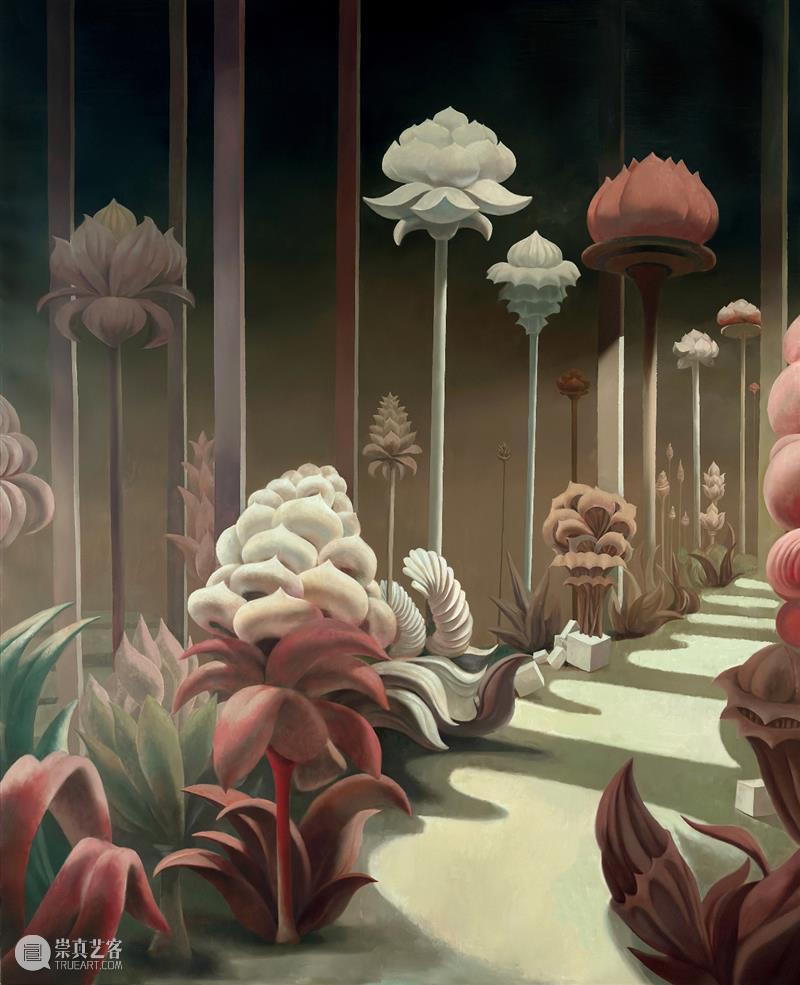
秘密花园/Secret Garden
2023
布面油画/ Oil on Canvas
150×120cm
以下展览正在展出
相关阅读
关于ARR

ARR GALLERY
开放时间:周二 - 周日 I Tuesday to Sunday
Hours:10:30 - 17:30
预约看展请电联:13588280435 姚先生
滨江区长河街道滨安路1188号元巢科创园2幢2楼168号
No.168,2F, No.2, Yuan Chao S&T Creation Park, No.1188, Binan Road, Changhe Avenue, Binjiang District


已展示全部
更多功能等你开启...

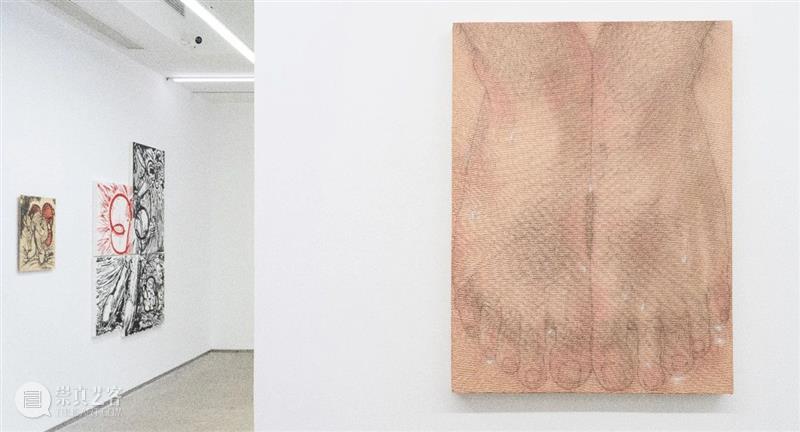





 分享
分享